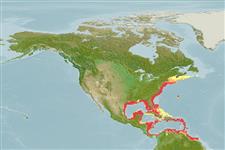Common names from other countries
>
Eupercaria/misc (Various families in series Eupercaria) >
Priacanthidae (Bigeyes or catalufas)
Etymology: Pristigenys: Greek, pristis = saw + Greek, genys, -yos = face (Ref. 45335).
More on author: Gill.
Environment: milieu / climate zone / depth range / distribution range
বাস্তুসংস্থান
সামুদ্রিক রীফ সংশ্লিষ্ট; গভীরতার পরিসীমা 5 - 200 m. Subtropical; 45°N - 5°N, 98°W - 53°W
Western Atlantic: east coast of North America, Gulf of Mexico and the Caribbean. Aside from records from Brazil (which are in error), there are no other records from South America or in eastern Atlantic waters.
আকৃতি / ওজন / Age
Maturity: Lm ? range ? - ? cm
Max length : 30.0 cm TL পুরুষ/ লিঙ্গ অনিধর্ারিত ; (Ref. 7251); common length : 20.0 cm TL পুরুষ/ লিঙ্গ অনিধর্ারিত ; (Ref. 5217)
Found on rocky bottoms between 5 (Ref. 5403) and 200 m depth, usually solitary and possibly territorial.
Life cycle and mating behavior
Maturities | প্রজনন | Spawnings | Egg(s) | Fecundities | শুককীট
Starnes, W.C., 1988. Revision, phylogeny and biogeographic comments on the circumtropical marine percoid fish family Priacanthidae. Bull. Mar. Sci. 43(2):117-203. (Ref. 5403)
IUCN Red List Status (Ref. 130435)
CITES (Ref. 128078)
Not Evaluated
Threat to humans
Harmless
Human uses
মৎস্য: আকর্ষণবিহীণ ; মৎস্যাধার / এ্যাকুয়ারিয়াম : বাণিজ্যিক
হাতিয়ার
Special reports
Download XML
ইন্টারনেট সুত্র
Estimates based on models
Preferred temperature (Ref.
115969): 10.3 - 27.5, mean 24.3 (based on 228 cells).
Phylogenetic diversity index (Ref.
82804): PD
50 = 0.5313 [Uniqueness, from 0.5 = low to 2.0 = high].
Bayesian length-weight: a=0.02239 (0.00929 - 0.05398), b=2.93 (2.73 - 3.13), in cm Total Length, based on LWR estimates for this (Sub)family-body shape (Ref.
93245).
ট্রফিক পর্যায়ে (Ref.
69278): 3.9 ±0.5 se; based on size and trophs of closest relatives
স্থিতিস্থাপক (Ref.
120179): উচ্চ, সর্বনিম্ন প্রজন দ্বিগুনের সময় ১৫ মাস (Preliminary K or Fecundity.).
Fishing Vulnerability (Ref.
59153): Low vulnerability (20 of 100).
